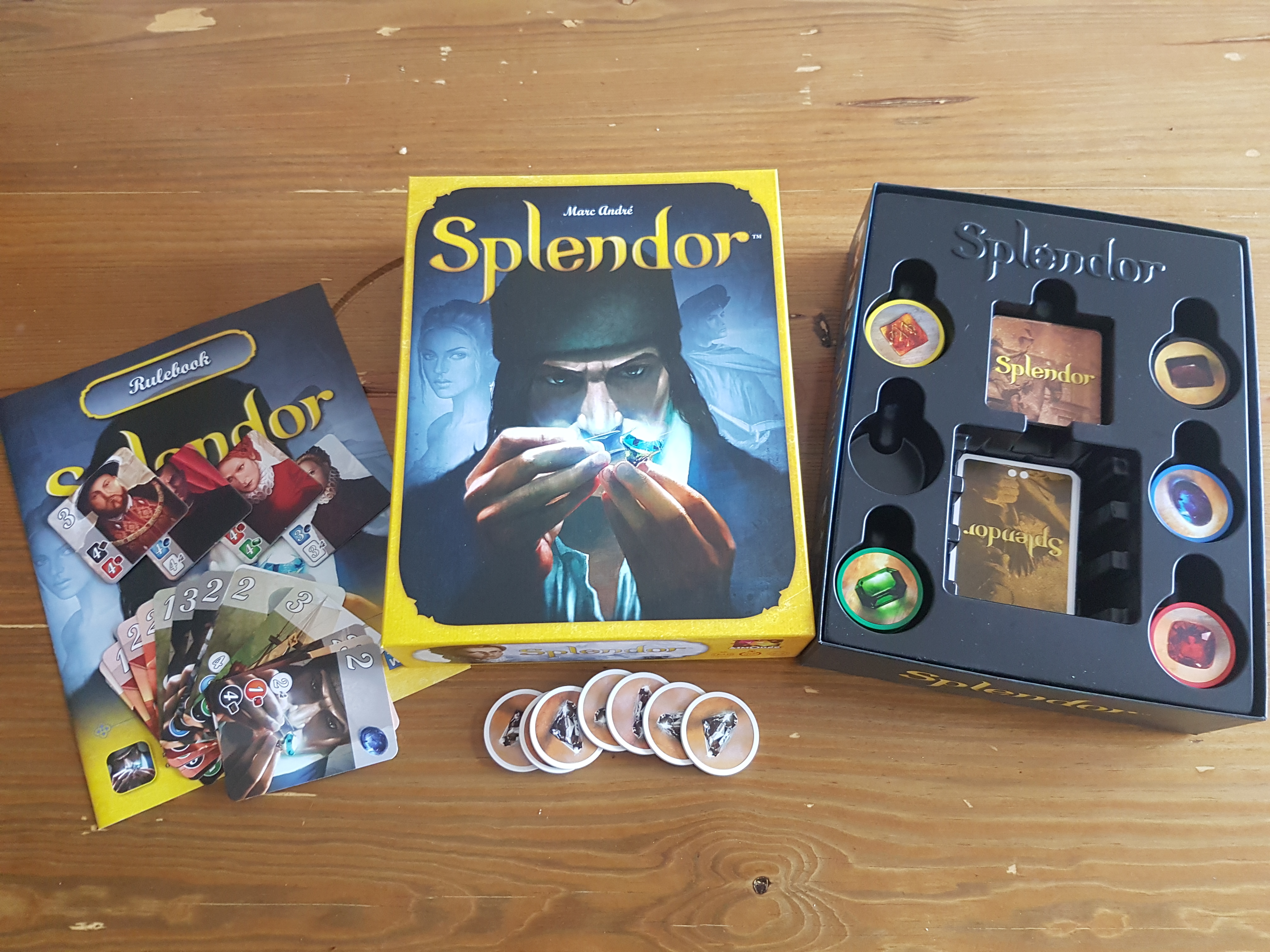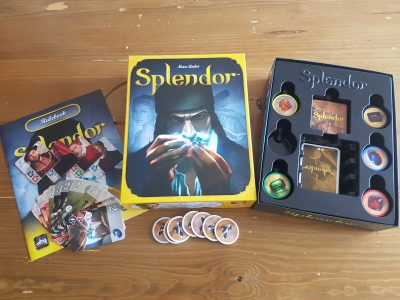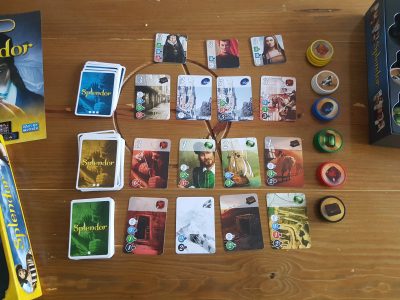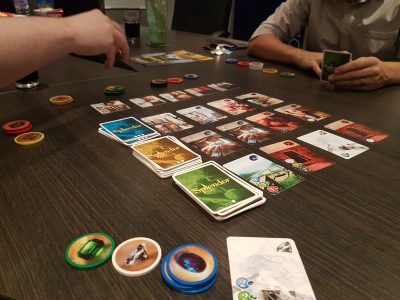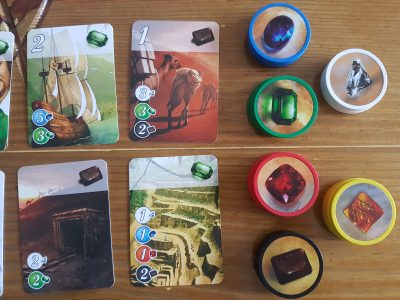Splendor is a cross between a card building and resource management game from Space Cowboys and Asmodee. Splendor is for 2-4 players and comes with a suggested time of 30 minutes per game. As the game progresses players will be able to buy bigger and better cards, earning more points and even visits from Nobles. It’s first to 15 prestige points, so a nice easy target but how do you get those points and is it worthwhile? Let’s find out.
At the start of the game players each player starts equally with nothing. A 4×3 grid of cards lays in the middle of the table, made up of 4 cards of each of the three tiers of cards. Each tier is progressively more expensive to purchase; offering juicier amounts of prestige points, which helps you towards winning. Above the cards are a selection of Nobles, the number of Nobles is equal to the player count plus 1. These give a player bonus points when they visit. For a Noble to want to visit a player they must have a number of cards producing resources – for instance 3 Oynx cards and 3 Emerald cards. Each Noble is looking for a different thing and provides 3 bonus points.
Sat above this is the final element of the “game board”, the bank. The bank has a set amount of Gold and Gem chips depending on the player count, with a full 7 of each Gem being used for a 4 player game and 3 being removed of each type for a 2 player game. These chips are what players will be solely using in the early rounds to purchase cards, that can reduce the cost of future cards.
On a given turn players have the option of one of four actions. They may take 3 Gem chips of differing colours or two Gems of the same colour: as long as there are still two or more of that Gem type remaining afterwards. The third available action is to purchase a card, either from the table or their hand. This is done by paying to the bank the number of Gems it says on the card, for instance 1 Ruby and 3 Diamonds, with Gems from their hand or from pre-built cards.
The final action available to players is reserving a card, an action as much about screwing other players over as helping yourselves. Reserving a card means you choose one from the table, put it into your hand so no one else can build it and you get to take a Gold piece. Gold is a joker style chip which can be used as any Gem type and reserving is the only way to obtain these Gold chips.
The resource side of Splendor reminds me of the choices players must make in 7 Wonders. Different techniques are available to players. Players can try to maximise their free resources early on, mostly at the expense of points. They could focus on only a couple of bonus Gem types to get visited by a Noble or disregard patterns and just go for what gets them points. The first time you play Splendor you’ll have a good time. It is after this that the game evolves into a game that will continue to return to your table. Past the first few games and you’ll start to see strategies appearing.
Strategies used also need to be adapted depending on the player count. This is partially due to the difference between a 2 player and a 4 player game being 3 gems of each kind. All of a sudden, those higher scoring cards, which as an example come with costs of 5 Gems of one colour and 3 of another, are actually viable as the first card to work towards. It’s still possible in a 2 player game but it feels easier in a 4 player game.
Naturally with more players the time between goes increases. Splendor does a great job of keeping players involved. Due to the short actions, even with the full 4 players the downtime between goes is incredibly short. This helps the game feel fast paced and keeps players engaged throughout. On top of this, the concept of the game is a simple one. This makes it a great gateway game for new board gamers.
The replayability is added by the strategies but these can be developed quickly so don’t discourage new players. The sheer number of cards, 90 in total, and the selection of Nobles you take, from the 10 in the box, also means no two games are the same. It would be nice to see some variation in Noble points, with easier and harder cards offering the variation. I feel it may add a bit more competition into getting the easier ones but also would add to the strategy element. Nevertheless, I can see why the Nobles are all worth 3 points as it means any one of them is then equal to another, so no “right” path is obvious.
Often when you open a board game for the first time you’re waiting for the moment when the components blow you away. While they are of decent quality the contents of the Splendor box are slightly underwhelming to look at. The tiny rulebook however does exactly what it needs to. It spells out the simple rules so players understand from the get go every mechanic of the game. One element of the components I’d like to highlight is the distinctive colours and symbols used for the Gems. The colours make the Gems and Gold easily recognisable on the cards and the chips. The symbols extend this and allow those with colour blindness to easily distinguish one from another. Even if this was not the intention of the developers it work perfectly so no one feels disadvantaged.
One thing Splendor offers is a limited opportunity for luck to seep into a game. As there are multiple cards to pick from in the 4×3 grid, which is the same for all player, it reduces the luck element that players could draw better cards than another player. There is still the potential one card that a player needs is turned over at the right time but chances of that happening when there are 90 cards is low. As everyone starts from nothing, players also see it as a level playing field from the very start of the game.
Splendor’s theming is nice but you could easily strap on a sci-fi theme and the entire game would still work with no mechanics feeling out of place. The old-world theme of Nobles, Gems and Gold all work well together, so it isn’t really a problem, it just doesn’t excite me going into the game. Naturally, I’d rather an issue with a weak theme than a weak game mechanically and that is what Splendor offers, substance over style. Issues with the theming aside the artwork is incredible. If it wasn’t the fact that the theme felt tagged-on the beautiful illustrations on the cards would massively propel the game forward. However, it just means that the game is visually pleasing without adding to the game.
Splendor certainly has some strategy but not too much for a game like this. It does fall into the category of a filler game but these shouldn’t be shunned. You need to break up big, full on games and Splendor is a great choice for that exact time. It’ll also be great for introducing new players to the hobby and is easy to breakout at small family gatherings where weightier games would be out of place. Personally, I preferred the ever so slightly more cutthroat side of the 2 player games I’ve played but by no means would I turn down a 3/4 player game. Overall, Splendor is simple to pick up, plays quick, and always leaves me wanting more.
If you’re not completely sure whether you want to buy the board game there is an app version available. This way you can get a feeling of the board game itself. In my opinion board games are best for social interaction, with players sat around the table, nevertheless if it’s an app version that gets you into the hobby don’t let anyone stop you!
[Editor’s Note: Splendor was provided to us by Esdevium Games for review purposes.]

